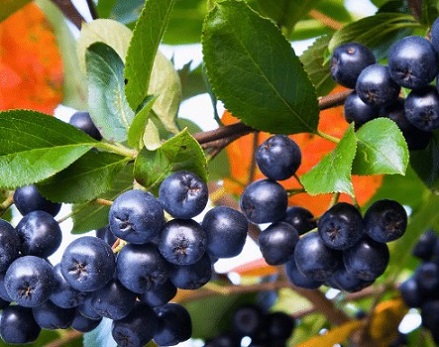Aronia-berry-extract-overcomes-pancreatic-cancer-drug-resistance-via-MYD88/NF-κB/P-glycoprotein modulation
Nikhil Prasad Fact checked by:Thailand Medical News Team Jul 11, 2024 1 year, 5 months, 21 hours, 12 minutes ago
Cancer News: New Hope in Pancreatic Cancer Treatment: Aronia Berry Extract
Pancreatic ductal adenocarcinoma (PDAC) is one of the deadliest forms of cancer, primarily due to its resistance to conventional chemotherapy drugs like gemcitabine (Gem). A recent study led by researchers from the Beckman Research Institute of City of Hope-USA, Yangpu Hospital-China, The First Affiliated Hospital of Dalian Medical University-China, The Translational Genomics Research Institute-USA, and Institut d’Investigacions Biomèdiques August Pi i Sunyer (IDIBAPS)-Spain explored an exciting new approach to overcoming this resistance.
 Aronia berry extract overcomes pancreatic cancer drug resistance via
Aronia berry extract overcomes pancreatic cancer drug resistance via
MYD88/NF-κB/P-glycoprotein modulation
This
Cancer News report delves in to this study that explores into how aronia berry extract (ABE) can enhance the effectiveness of gemcitabine in treating PDAC.
The Problem with Pancreatic Cancer
Pancreatic cancer is notoriously difficult to diagnose early and treat effectively. Despite advances in medical science, the five-year survival rate for PDAC remains dismally low. One major challenge is that PDAC cells often become resistant to gemcitabine, a cornerstone of chemotherapy for this disease.
Aronia Berry Extract: A Natural Ally
Aronia berries, also known as black chokeberries, are packed with phenolic compounds that have potent antioxidant and anti-inflammatory properties. Previous studies have suggested that these compounds can help combat cancer by targeting various pathways involved in cell growth and survival. The new study focused on whether ABE could help overcome gemcitabine resistance in PDAC cells.
The Study
Researchers conducted a series of experiments using gemcitabine-resistant PDAC cell lines and patient-derived 3D tumor organoids. They found that combining ABE with gemcitabine significantly improved the treatment's effectiveness
Key Findings
-Synergistic Effects on Cell Viability: The study demonstrated that ABE, when used alongside gemcitabine, significantly reduced the viability of gemcitabine-resistant PDAC cells. This was evident in both cell cultures and 3D tumor organoids derived from patients.
-Impact on Cell Proliferation and Migration: The combination of ABE and gemcitabine inhibited cell proliferation, migration, and invasion much more effectively than either treatment alone. This was confirmed through various assays, including colony formation, wound healing, and transwell invasion assays.
-Inducing Cell Apoptosis: The combined treatment also promoted apoptosis (programmed cell death) in PDAC cells. This was evidenced by an increase in apoptotic markers like cleaved caspase-9 and Bax, and a decrease
in anti-apoptotic markers like total PARP.
-Targeting Key Molecular Pathways: A significant part of the study involved understanding how ABE enhances gemcitabine sensitivity. The researchers discovered that the MYD88/NF-κB signaling pathway plays a crucial role in gemcitabine resistance. MYD88 is an adaptor protein that can activate NF-κB, a transcription factor involved in inflammation and cell survival. The study found that MYD88 was upregulated in gemcitabine-resistant cells and that ABE could suppress this pathway, thereby reducing resistance.
-Reducing P-glycoprotein Expression: P-glycoprotein (P-gp) is a protein that helps cancer cells expel drugs, contributing to chemotherapy resistance. The study showed that ABE reduced the expression of P-gp in resistant PDAC cells, further enhancing the effectiveness of gemcitabine.
Mechanism of Action
The combination of ABE and gemcitabine works by targeting the MYD88/NF-κB pathway. By suppressing this pathway, ABE helps to reduce the expression of P-gp, making cancer cells more susceptible to gemcitabine. This dual action of inhibiting survival pathways and promoting drug retention within the cells makes the combination particularly powerful against gemcitabine-resistant PDAC.
Validation in Patient-Derived Organoids
To ensure that these findings were not limited to cell lines, the researchers tested the combination therapy on 3D tumor organoids derived from PDAC patients. These organoids closely mimic the behavior of actual tumors in the body. The results were promising: the combination of ABE and gemcitabine significantly reduced the size and number of organoids, suggesting that this therapy could be effective in a clinical setting.
Conclusion and Future Directions
This study provides compelling evidence that aronia berry extract can significantly enhance the effectiveness of gemcitabine in treating pancreatic cancer. By targeting the MYD88/NF-κB/P-gp axis, ABE helps to overcome one of the biggest challenges in PDAC treatment: chemoresistance.
The researchers are optimistic about the potential of this combination therapy and suggest that further studies, including clinical trials, are necessary to fully understand its benefits and applications. If successful, this could lead to a new, more effective treatment option for patients with pancreatic cancer.
The study findings were published in the peer-reviewed journal: Pharmaceuticals.
https://www.mdpi.com/1424-8247/17/7/911
For the latest
Cancer News, keep on logging to
Thailand Medical News.
Read Also:
https://www.thailandmedical.news/news/-metformin-a-surprising-new-hope-for-pancreatic-tumor-treatment
https://www.thailandmedical.news/news/university-of-nebraska-study-finds-that-micrornas-play-key-roles-in-pancreatic-cancer
